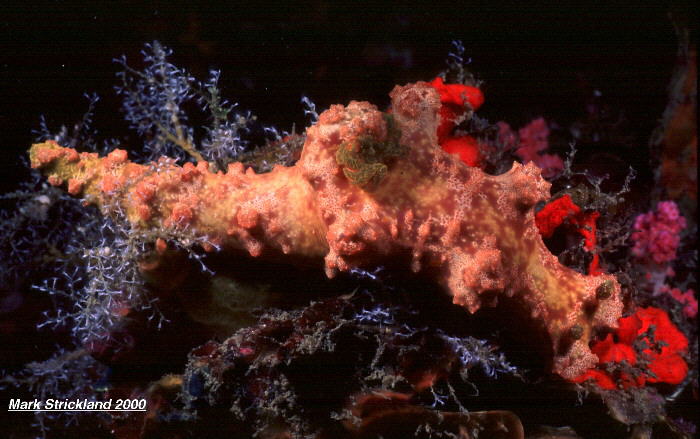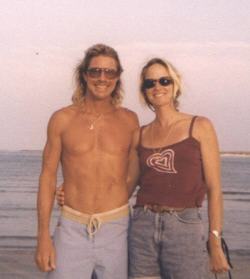 |
Ceratosoma moloch
Photo taken by Mark Strickland, Thailand 2000
Photo cannot be reporduced without written permission of Mark Strickland
Ceratosoma moloch Rudman, 1988
Members of the genus Ceratosoma display amazing diversity both in color and body form. When most of us think of Ceratosoma we think of the bright aposomatic colored, smooth bodied species like Ceratosoma trilobatum and C. gracillimum. There are however a couple curious beasts, that have strayed from this attire and have variably textured bodies, making themselves quite cryptic. Ceratosoma moloch is one of these.
As mentioned in Richard Willan's column in the recent issue of the Australasian Nudibranch News. C. moloch has an interesting name,lacking the usual "-ae", "-i", "-orum" or "-ensis" ending. The name, which is a noun (actually a noun in apposition), is taken from the scientific name of an ugly reptile, the Australian Thorny Devil, or Moloch horidus, from which Bill Rudman saw similarities in appearance and movement.
Ceratosoma moloch, is a large dorid nudibranch, reaching 140 mm Nudibranchs of Heron Island , species Figure 158). It is distinguished by its large compound pustules over the body and foot. Several large pustules form an enclosure around the gills, which are retractable into the gill sheath.
Mark's documentation of this specimen from Thailand adds significantly to the range of this relatively rare species, which to date is thought to be, Australia, the Solomon Islands and Indonesia.
C. moloch is probably a sponge eater, but I have tried to think of what substrate its pustulose mantle resembles. Of the other two cryptic species of Ceratosoma, the elongate dorsal projections of Ceratosoma alleni look striking similar to the polyps of several soft corals (even though it too is a sponge eater), and the bizarre Kukungan Bay beast , captured by Denise Tackett, clearly resembles a sponge, complete with spiculate appearance.
C. moloch is not as horrid in physical appearance as the Thorny Devil, but it the two do have similar mannerisms in their crawl, rolling side to side as they go.
Thanks Mark for sharing your beautiful shot, of this rare species, with us.
Dave Behrens
Danville, Calif
Sept. 2000

|
Mark Strickland has had a close relationship with the sea from an early age. Growing up in Florida, he has worked many years as an ocean lifeguard, a boat captain, and a diving instructor. Mark's passion for underwater photography has led him to many of the world's best diving areas throughout the Indo-Pacific and elsewhere. While each of these areas has offered something special, many of Mark's favorite dives are in the vicinity of Phuket, Thailand, where he's been based since 1988. Most of each year, Mark and his wife Suzanne can be found on Fantasea Divers' live-aboard divevessel where they have served as Cruise Director / Divemaster / Photo-pro since 1990.
Mark's photos and articles have appeared in dozens of magazines and books
throughout the world. He is also principle author of the book "Scubaguide
Thailand", and co-author of Lonely Planet's new title, "Diving and
Snorkeling Thailand". In addition to representation by several stock photo
agencies, Mark operates his own stock photo library, Oceanic Impressions. |
Taxonomic information courtesy of Dave Behrens

David W. Behrens
Author:
Pacific Coast Nudibranchs
Send Dave mail at seachalleng@earthlink.net
|
